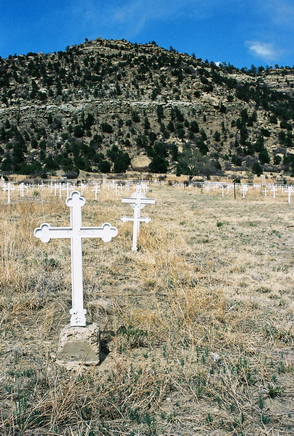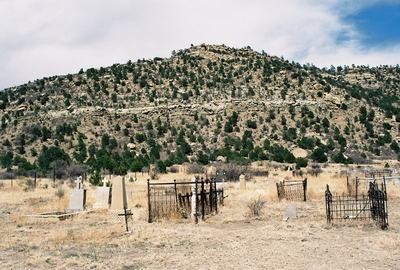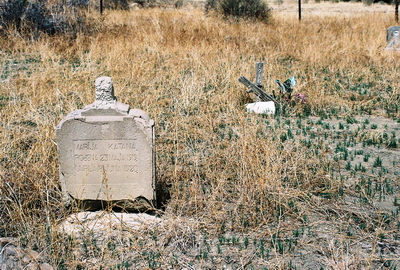
It's dark as a dungeon and damp as the dew;
Where the dangers are double and the pleasures are few;
Where the rain never falls and the sun never shines;
It's dark as a dungeon way down in the mines.
Dark as a Dungeon, Merle Travis, 1946.
Many towns across the United States have lived and died on mining. In New Mexico, the landscape is pocked with abandoned mine shafts and it seems that countless towns and the lives that were lived in them have come and gone with the minerals. Most of us might be able to think of one or two mining disasters. Twenty-nine people were killed in West Virginia’s Upper Big Branch Mine less than 2 years ago, for example. But not many people have heard of Dawson, New Mexico, of which so little remains that it can barely be called a ghost town now. The disappearance of Dawson, both in the collective memory and literally, is unfortunate because what happened there in the early part of last century was of some importance.
In 1867, J.B. Dawson decided to purchase about 1,000 acres of land northeast of Cimarron for $3,700. In one of those rare errors that actually put the mistaken party ahead it turned out that Mr. Dawson had really purchased 20,000+ acres with a large coal seam to boot. When Mr. Dawson finally sold his property to the Dawson Fuel Company in 1901, it went for $400,000. The Dawson Fuel Company started mining coal in earnest, but sold out in 1906 to the Phelps Dodge Corporation, who built a town with everything a person of the day could want: a bowling alley, schools, theaters, a hospital, an opera house, and a golf course. At its peak, about 9,000 people called Dawson home and men came from all around the world to work in the ten surrounding mines.
 Then, on October 22, 1913, an explosion in Stag Canon Mine No. 2 sent fire spitting 100 feet out of the mouth of the mine. A dynamite charge had been mistakenly set, in breach of safety protocol, and ignited airborne coal dust. A massive rescue effort was undertaken with crews arriving from as far as El Paso, Texas, but only 23 miners survived. The final death toll numbered 263, making the Stag Canon Mine No. 2 disaster the 2nd worst in U.S. history. Two rescue workers were also killed in their efforts. Special white crosses were erected in the Dawson cemetery to mark the graves of those that lost their lives.
Then, on October 22, 1913, an explosion in Stag Canon Mine No. 2 sent fire spitting 100 feet out of the mouth of the mine. A dynamite charge had been mistakenly set, in breach of safety protocol, and ignited airborne coal dust. A massive rescue effort was undertaken with crews arriving from as far as El Paso, Texas, but only 23 miners survived. The final death toll numbered 263, making the Stag Canon Mine No. 2 disaster the 2nd worst in U.S. history. Two rescue workers were also killed in their efforts. Special white crosses were erected in the Dawson cemetery to mark the graves of those that lost their lives. 
But when mining is all a town knows, it’s not long before the work resumes. And, in a mine shaft, with a return to work comes a return of risk. So it was that on February 8, 1923 a train jumped the track and hit timbers which were supporting Stag Canon Mine No. 1. The impact once again ignited coal dust and 122 more miners were suddenly dead. Many of those killed were sons whose fathers had died in the Mine No. 2 disaster less than 10 years prior. Now many of Dawson’s women had lost both their husbands and their sons to the mines. More white crosses were erected in the cemetery.
Yet the mines operated until 1950, when a 25-year coal contract with the Southern Pacific Railroad ended and extracting the remaining coal was not profitable. In April of that year, residents were suddenly given 30 days to leave their homes and Dawson was then quickly dismantled and sold. Most of Dawson is now lost to the ages, although the big Phelps Dodge Corporation safe reportedly resides in a museum in Bisbee, AZ. When Philip Varney visited over 30 years ago, he walked down the old dirt road to talk with the then-owners of Dawson and have a look at the very few remaining homes and structures, which included a gas station and some coke ovens (since demolished).
 In that time things have changed a bit and I was not about to climb the gate, heavily posted with “No Trespassing” signs, and possibly try my luck with a ranch hand. But the cemetery, which was once just outside of town, is open to the public and is now the only visible remnant of Dawson. Family members still gather at the cemetery to reminisce and remember their loved ones. A number of the graves are well-kept with recently-placed flowers. But other graves are broken and forgotten. There are row upon row of names. Polish, Czech, Italian; many written in the native tongue. One lonely grave is of Marck Zamponi, a member of the “Wagoner 9 Engrs.” The stone simply says “Minnesota” (my home state) and there is an accompanying date of death: June 11, 1927. Did this man leave his family up north behind? Did they even know he was dead, let alone buried below a hill in a sooty coal town in northern New Mexico? After all these years, his story, like so many others, is forgotten and will never be told again.
In that time things have changed a bit and I was not about to climb the gate, heavily posted with “No Trespassing” signs, and possibly try my luck with a ranch hand. But the cemetery, which was once just outside of town, is open to the public and is now the only visible remnant of Dawson. Family members still gather at the cemetery to reminisce and remember their loved ones. A number of the graves are well-kept with recently-placed flowers. But other graves are broken and forgotten. There are row upon row of names. Polish, Czech, Italian; many written in the native tongue. One lonely grave is of Marck Zamponi, a member of the “Wagoner 9 Engrs.” The stone simply says “Minnesota” (my home state) and there is an accompanying date of death: June 11, 1927. Did this man leave his family up north behind? Did they even know he was dead, let alone buried below a hill in a sooty coal town in northern New Mexico? After all these years, his story, like so many others, is forgotten and will never be told again.
As usual, I’ve relied heavily on Philip Varney’s New Mexico ghost town guide for this post. The wikipedia entry for Dawson is also quite good.
I do love reading about the mining towns and cemeteries. They have the best stories. Nice pictures!
ReplyDeleteIf you like mining towns and cemeteries then the Southwest is definitely the place for you!
ReplyDeleteThanks for the comment!
Adsila and I wrote a book going to 12 abandoned sites in AZ. She photographed and I did psychic reads, bringing a scene from the past alive a gain. We are huge URBEX'ers in AZ. If you're ever our way, let us know. We'd seriously love to hang with you and show you some amazing places. Love your blog!
ReplyDeleteYou guys aren't too far away! I bet we'll be able to cross paths before too long. I'll be in Arizona again this fall, I think, so I'll keep you posted. And if you make a trip to New Mexico, let me know. Your blogs are really cool and it'd be great to do a little exploring together!
ReplyDeleteI love seeing these pictures and your stories as well. My father is from Dawson NM and did some work in the mines before joining the Army Air Force. In looking through some of his belongings I found one of the old Wolf safety lamps. Have a few other item as well. I find it interesting looking at all of this stuff.Thanks for all you've posted.
ReplyDeleteSusan Whiteley, that's really incredible that your father is from Dawson and worked in the mines. That must've been a very challenging lifestyle, one made especially poignant by the tragedies Dawson experienced.
ReplyDeleteThanks very much for your comment. I'm glad you enjoy City of Dust! JM